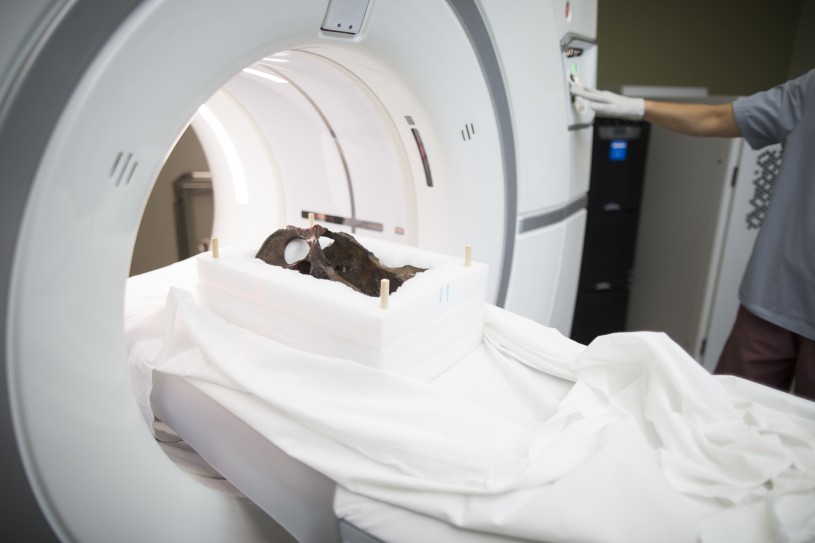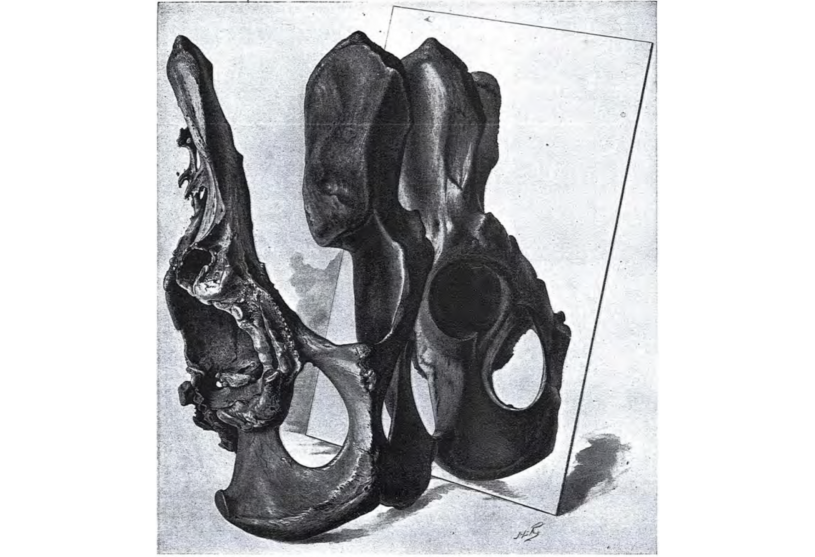Los Angeles, CA (May 22, 2023) — A new display at La Brea Tar Pits explores how the journey of a fossil from initial discovery through detailed study can lead to groundbreaking scientific research. The three revamped cases track the excavation of fossils from the Tar Pits, their preparation, and the innovative science that makes new discoveries possible even on fossils that have been investigated for more than a century.
The third case, focused on research, displays a healthy adult femur and pelvis (hip bones) of a saber-toothed cat next to a pathological specimen—a fossil that shows signs of injury or disease—alongside a monitor displaying X-ray images from a CT scan. That final case (made possible through an innovative scientific collaboration between the Tar Pits and nearby Cedars-Sinai Hospital) communicates the recent discovery supporting the idea that saber-toothed cats were social animals.
Advancements in medical science rewrote the story of this saber-toothed cat originally thought to have been crippled from injury and infection. Orthopedic doctors at Cedars-Sinai partnered with Tar Pits scientists to look at the internal bone structure of the supposed injury using advanced medical technology and discovered that this saber-toothed cat in fact was born with hip dysplasia, a common affliction found today in pet cats and dogs.
“In this case, our animal sustained a developmental condition [not an injury] and was able to live to adulthood—suggesting that it must have received support, perhaps by food-sharing with its family,” says Dr. Mairin Balisi, Research Associate at the Tar Pits and lead author of the original study about the fossil’s hip dysplasia discovery.
Hobbled since it was a kitten, this individual likely could not have survived to adulthood on its own. While today’s pets might get a new hip or careful pampering by human owners, a Smilodon would have been left to nature. But this big cat’s long life span suggests that these big cats took care of one another.
“In Smilodon's case, we are lucky to have multiple lines of evidence—a lot of them from La Brea Tar Pits—suggesting that it was social,” Balisi says. “Thousands of individuals are preserved here, which is more likely if Smilodon had been social than solitary.”
“This study is a great example of how scientific knowledge evolves through the inclusion of new perspectives and technologies,” says Dr. Emily Lindsey, Assistant Curator and Excavation Site Director at La Brea Tar Pits. “People have been thinking about this bone for more than a century, but when you have a top medical facility literally just down the block from a world-famous fossil site, it opens up whole new worlds of possibilities.”
About the Natural History Museums of Los Angeles County (NHMLAC)
The Natural History Museums of Los Angeles County (NHMLAC) include the Natural History Museum in Exposition Park, La Brea Tar Pits in Hancock Park, and the William S. Hart Museum in Newhall. They operate under the collective vision to inspire wonder, discovery, and responsibility for our natural and cultural worlds. The museums hold one of the world’s most extensive and valuable collections of natural and cultural history—more than 35 million objects. Using these collections for groundbreaking scientific and historical research, the museums also incorporate them into on- and offsite nature and culture exploration in L.A. neighborhoods, and a slate of community science programs—creating indoor-outdoor visitor experiences that explore the past, present, and future. Visit NHMLAC.ORG for adventure, education, and entertainment opportunities.

